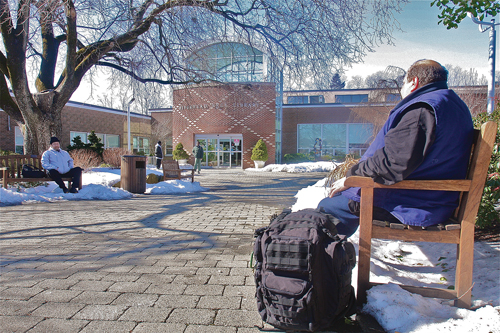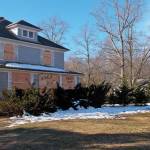Amid frigid winter, homeless seek more help from shelters

On a recent weeknight, one Aquebogue church is barely visible from Main Road in the pitch dark.
But around back, the lights are on and 13 cars are parked in the rear lot, one van having just left. Inside Our Redeemer Lutheran Church, some of the area’s homeless are gearing up for a hot meal and warm place to stay.
Our Redeemer is just one of two houses of worship sheltering the homeless across the East End this night, part of a group of nearly 40 that unite each week during the winter — through local nonprofit Maureen’s Haven — to put a roof over the heads of the local homeless population.
It’s an effort that has required a heavier lift this year than in seasons past; Maureen’s Haven appears on track to serve more homeless this winter than ever before. After topping a previous high last season, housing 312 individuals over 108 nights, the organization has already served over 80 percent of that total this year, with nearly another month to go.
“I believe we’ll end up having more than last year. Obviously, it’s just been a brutal winter,” said Tracey Lutz, executive director of Maureen’s Haven. She’s been with the nonprofit since 2010. This winter season has seen the third-highest snowfall total in 30 years, weather officials say. And then there was the “polar vortex” that swept ice-cold weather through the region in January.
“The other part is, more and more people are losing homes and don’t have enough resources to get into another one,” Ms. Lutz said. “The numbers are really alarming.” It’s not a situation unique to Riverhead.
The Long Island Coalition for the Homeless conducts an annual “point-in-time” count each winter in Suffolk and Nassau counties, counting the island’s homeless in a single day with the help of volunteers. This year’s count, taken in late January, has yet to be tallied, but Greta Guarton, executive director of the Garden City-based nonprofit, said she already has a feeling this year’s numbers will be up.
She points in large part to Hurricane Sandy: While many apartments that were swept away in the storm might not have been legal for a lot of families to live in, the cheaper price that came with them fell by the wayside when they were knocked out in late 2012. The families weren’t counted as homeless in 2013 because they were still receiving federal aid that kept them off the streets — aid she says has likely dried up by now.
•
But even the numbers don’t tell the whole story, Ms. Lutz said.
“There are so many living in the woods that don’t come in at all,” she said.
The transient nature of the homeless population creates a challenge for those attempting to find out how many people without a place to live, actually populate a certain area.
Single adults make up 64 percent of the homeless population, according to the Department of Housing and Urban Development’s 2013 Annual Homeless Assessment Report.
While some homeless people choose to take shelter in the area’s woods, others live two, three or four to a bedroom in overcrowded homes on a night-to-night basis, Ms. Lutz said.

A few of these homes have made their way into the local headlines as of late, as the town recently brought one homeowner to court for allegedly owning several overcrowded properties. Authorities said 18 people were living in one of the Polish Town homes before code enforcement broke it up.
While the overcrowded homes are considered a safety hazard, other options — from squatting in a vacant building to just wandering the streets at night — can be just as dangerous, if not more so, for the homeless, as recent incidents of violence would indicate.
On Feb. 15, town police said nine homeless men were drinking inside an abandoned home on West Main Street when a fight broke out, and most of them were injured and four were hospitalized. No arrests were made because none of the men cooperated with police. Days after the drunken brawl, four structures on two adjoining properties were boarded up with plywood, with “KEEP OUT” spray painted on several boards.
Less than a week later — last Thursday morning — another homeless man was taken to the emergency room after being assaulted with a hammer on Roanoke Avenue about 3:45 a.m. Days after that assault, a homeless acquaintance of the victim told one reporter “he probably deserved it.”
About 21 hours after the hammer assault, yet another homeless man was beaten nearly unconscious at the intersection of Pulaski Street and Marcy Avenue. When he was found, he was unable to speak and was rushed to Stony Brook University Hospital. That assault remains under investigation by police.
•
Chief David Hegermiller said recently — just before the Polish Town beating, actually — that Riverhead’s homeless population is not in itself a drain on the police department.
“But any kind of homeless situation that leads to criminal activity — that’s where it becomes a drain,” he said. “Do they go hand in hand? I don’t know that they go hand in hand. I know that it makes people uncomfortable.”
He said he doesn’t remember homelessness being a law enforcement issue when he stepped into his current office 12 years ago, and added that he doesn’t recall it being an issue five years ago either.
The chief described himself as old-fashioned: “You get a job, take care of yourself, that kind of thing.”
While he said organizations like Maureen’s Haven “do a nice job,” he also wonders if they’re fixing the problem. Then he answers: “I don’t think it’s fixing the problem.”
But the chief also acknowledged the role mental illness plays as a barrier to individuals looking for jobs and trying to take care of themselves. In fact, according to the Substance Abuse and Mental Health Service Association, about 30 percent of the chronically homeless population — those who are homeless for a year or more or have been homeless on several occasions within a few years — suffer from mental illness.
“So what do you do with these people?” Chief Hegermiller asked. “They need care. The problem is, they really can’t get along without care, or medication. I don’t know if the town’s going to do that. To me, I think that’s a state issue.”
Riverhead Supervisor Sean Walter echoed the chief’s sentiments, saying the town “doesn’t have a housing authority” as the state does to directly offer public housing. Likewise, Mr. Walter pointed out that those with psychiatric problems are “a completely different story” from those who are mentally sound. But he said many people on the streets have avenues available to them to help them rise out of poverty. It’s just a matter of using them.
“This town has a tremendous amount of compassion. But there’s a line here. We cannot make it comfortable to be homeless,” he said.
“I don’t think this is something we can just turn to government for,” Mr. Walter continued. “A lot of people want to say, turn to government. It has to correct it. That’s a misguided approach to things. Government has a place, as Suffolk County does, with housing emergency shelters and things of that nature. And they’re doing a good job.”
The supervisor said “the town is doing what it should be doing” and that he considers churches and outreach programs within the town part of the town’s effort to provide for the homeless.
That’s their role, he said, noting that the town does open buildings during emergencies for those in need.
“What we have to do is continue to support our churches, Maureen’s Haven, local outreach programs, Salvation Army — places like that,” he said. “I think that’s where the buck stops.”
Suffolk County Department of Social Services officials said they couldn’t immediately provide details on the number of homeless children living in Riverhead.
Some numbers available to the public though the U.S. Census Bureau include the number of children deemed to be living in poverty within the Riverhead School District through the 2012-13 school year and prior years. But those figures are estimates and don’t indicate an increase.
According to the census data, 625 children in the Riverhead district were counted as living in poverty in 2012-13 and 655 in 2011-12.
•
Charlie, one of the homeless men staying overnight at Our Redeemer, came to the East End specifically for Maureen’s Haven last fall. Charlie lost his job as a taxi driver after getting a ticket he couldn’t afford to pay. He said he was crossed off the DSS emergency housing list earlier this season because he missed an appointment and has been a guest at Maureen’s Haven since September.
It’s not uncommon for people to miss appointments, said Ms. Lutz of Maureen’s Haven, since the program could put someone at any place throughout the county, depending on where beds open up.
And time is limited, she added, since those looking for a place to stay can’t call until 4:30 p.m. to check availability.
“Say I’m calling from Riverhead and they have a bed available in Deer Park. I have to be able to get there,” she said. “So I gotta get on a bus in Riverhead, maybe transfer in Patchogue and Hauppauge. Chances are, I’m not going to get there” and the appointment will be missed.
But difficulty traversing the large county isn’t the only reason she finds people seek out her program.
Because Maureen’s Haven opts not to ask about immigration status — unlike county DSS, which requires that information — “We’ve absolutely seen an increase in the Latino population,” Ms. Lutz said.
John’s Place, an organization that previously partnered with Maureen’s Haven, now operates at Mattituck Presbyterian Church and St. Agnes R.C. Church in Greenport on the two nights a week Maureen’s Haven doesn’t offer housing. Apparently, the same is now true there.
Previously, said Sister Margaret Smyth, who volunteers with John’s Place, “it was always English-speaking Americans who dominated” the population in need of the church services.
No matter the clientele, however, most agree the private East End shelters are still safer than the alternatives.
Air mattresses are laid throughout church auditoriums each night for the homeless to sleep on — much more spacious than a few people to a room, Charlie recalls. Sobriety is required to get in the door, which volunteers say limits altercations and personality clashes.
And then there’s the home-cooked food. Dinner is offered at night and breakfast early in the morning, so those who have jobs can get to work. One Maureen’s Haven participant, Southold Presbyterian Church, even provides a live music performance for guests.
After dinner is served, Diane Burkhart, a volunteer coordinator at North Shore United Methodist Church — which runs Maureen’s Haven at Our Redeemer every other Monday — laments the fact that mason Nick Arata, a regular volunteer who just returned from a mission trip to Haiti, couldn’t be there to comfort the crowd, most of whom she knows by first name.
“Nick says, ‘Maybe we caught a lucky break or got some support form our family that these guys didn’t get,’” Ms. Burkhart said. “Maybe he’s right.”





